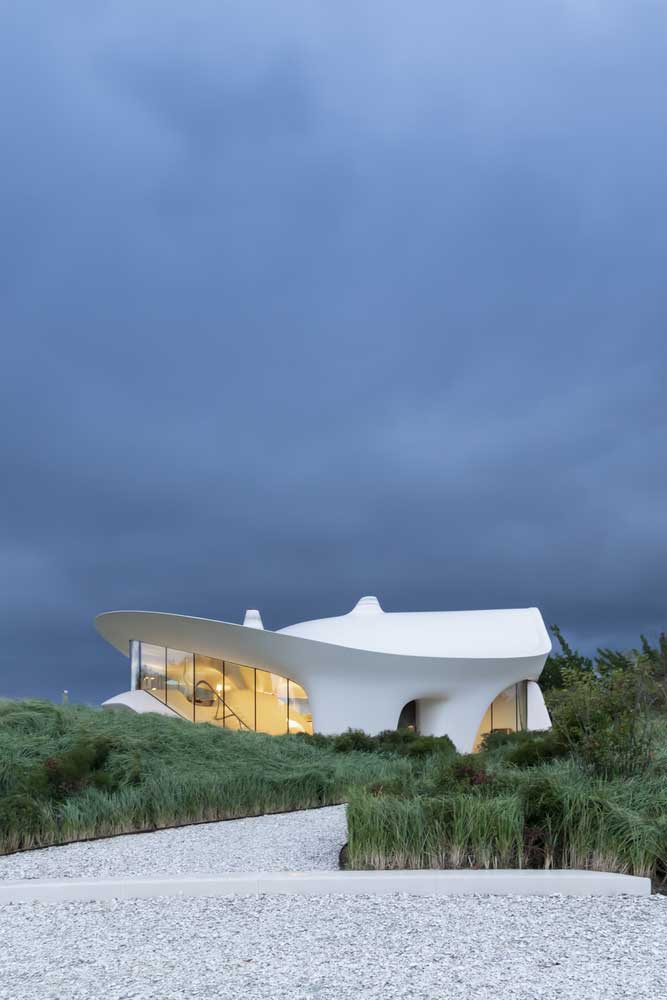In the realm of modern architecture, the interplay of form and material creates not just structures, but experiences. Among these, the use of cantilevered volumes and glass panes stands out as a testament to the innovation and boldness that define contemporary home design. This architectural narrative unfolds in a symphony of balance and light, where materials are not mere components but the very language of design.



| Architects | https://dsrny.com/ |
| Images | www.iwan.com |
Cantilevered Strength
Cantilevered volumes are a marvel in modern architecture, projecting strength and defying gravity. The use of steel and reinforced concrete allows these structures to stretch outward, creating overhangs that provide shade and dynamic visual interest. They embody the boldness of contemporary design, offering new possibilities for space utilization and aesthetic expression.
The architectural prowess of cantilevers is not just in their striking appearance but also in their functional benefits. They can create balconies and terraces that float above the ground, providing outdoor spaces without compromising the footprint of the building. This innovative use of space is a hallmark of modern design efficiency.
In residential design, cantilevered volumes are often used to maximize views and enhance the connection to the natural environment. They serve as a physical bridge between the indoors and outdoors, allowing residents to step out into the air, suspended above the landscape. This seamless integration is a signature of modern living.
The materials used in cantilevered construction are chosen for their durability and load-bearing capabilities. Advances in material science have expanded the potential for cantilevered designs, enabling architects to push the limits of how far these structures can reach. This has led to more daring and imaginative architectural forms.



Glass Panes Transparency
Glass panes offer a visual and physical lightness that complements the solidity of cantilevered volumes. They allow for unobstructed views and flood interiors with natural light, creating spaces that feel open and boundless. The transparency of glass encourages a modern, airy aesthetic that is both luxurious and minimalist.
The use of glass in modern homes extends beyond windows to become walls themselves, dissolving the barrier between inside and outside. This transparency fosters a living experience that is immersed in the surrounding environment, whether it be a bustling cityscape or a tranquil natural setting.
Energy-efficient glass panes are at the forefront of sustainable design, providing insulation and reducing the need for artificial heating and cooling. The incorporation of smart glass technologies can further enhance the home’s energy performance, adapting to changes in light and temperature for optimal comfort.
The strategic placement of glass panes can transform the ambiance of a space throughout the day. Morning light can fill a room with warmth, while evening light can turn it into a serene retreat. Glass becomes a canvas for the ever-changing play of light, offering a dynamic living experience.


Interplay of Light and Material
The interplay between cantilevered volumes and glass panes creates a dynamic architectural dialogue. The strength of cantilevers provides a stark contrast to the fragility of glass, crafting a visual tension that is both striking and harmonious. This contrast is a defining feature of modern architectural design.
Light plays a crucial role in this interplay, with cantilevered volumes casting bold shadows and glass panes reflecting the sky. The movement of light across these materials brings the architecture to life, creating a home that is in constant flux, responsive to the time of day and season.
The combination of these materials also allows for creative design solutions. Cantilevers can shield glass-walled rooms from the harsh sun, while the glass itself can enhance the sense of space within. Together, they create homes that are not just buildings but sensory experiences, engaging with their inhabitants on multiple levels.
Sustainability is enhanced by this material interplay. Cantilevered overhangs can reduce solar gain, while glass panes can maximize daylight. This thoughtful use of materials contributes to a home’s energy efficiency, reducing its environmental impact while enhancing the comfort and well-being of its residents.


Sustainability and Efficiency
Sustainability is a cornerstone of modern home design, with cantilevered volumes and glass panes playing a significant role. These materials are selected not only for their aesthetic appeal but also for their environmental performance. They contribute to the creation of homes that are energy-efficient and sustainable in the long term.
Cantilevered structures can be designed to minimize their ecological footprint, using materials that are recyclable and sourced responsibly. When combined with glass panes that offer thermal insulation, the result is a home that conserves energy while maintaining a comfortable living environment.
The orientation of cantilevered volumes and glass panes can be optimized to take advantage of passive solar heating and natural ventilation. This design strategy reduces reliance on mechanical systems, lowering energy consumption and promoting a healthier indoor climate.
Incorporating green technologies such as solar panels on cantilevered roofs or using smart glass that adjusts its transparency can further enhance a home’s sustainability. These innovations represent the future of eco-friendly living, where design elegance meets environmental consciousness.

The fusion of cantilevered volumes and glass panes in modern home design is more than an aesthetic choice; it’s a reflection of a deeper commitment to innovation, sustainability, and a harmonious living experience. These elements work in concert to create homes that are not only visually stunning but also functionally superior and environmentally responsible.












